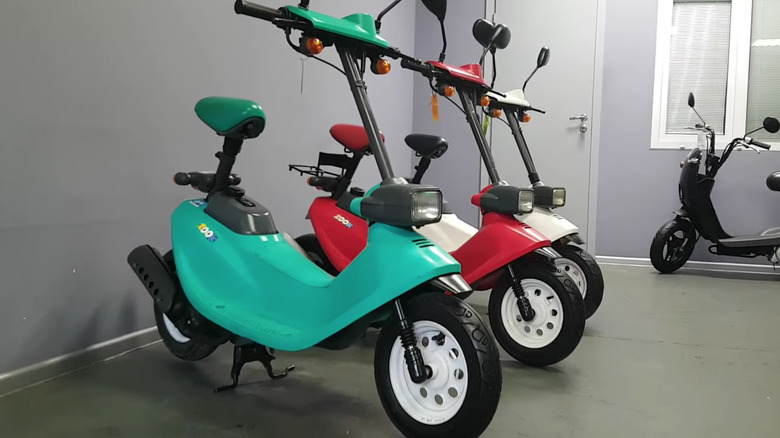Looking Back At One Of Honda's Oddest Creations: The Zook
In an era where — for better or worse depending on your opinion — small electric scooters like Lime and Bird dot the sidewalks of major cities, a product like Honda's Zook might not raise that many eyebrows, but in 1989 when it debuted, the Zook might have well come from a different planet. Looking like a cross between a skateboard and a mobility scooter for the elderly, the Zook was powered by a 49 cubic centimeter (cc) gasoline engine and could achieve a top speed of more than 30 MPH, which had to be terrifying for the rider considering the whole deal rolled on tiny 8-inch diameter wheels.
Those tiny wheels were shod in "footprint" tires. That is, the tire actually had a series of foot/shoe shapes molded into the tread. If you drove across a soft surface, like sand, the Zook would leave miniature footprints behind. As far as the funny name, Zook derives from the Japanese phrase "zuku," which translates to "the tendency to occur."
It was available in six creatively-named colors including but not limited to "Fur Gray," "May Leaf Green," "Jean Blue," and "Funky Brown." The fuel tank, which is visible in front of the seat post, holds two liters of gasoline, and a smaller tank for the necessary 2-stroke oil is concealed within the bodywork. At least owners didn't need to measure and mix the gas and oil together themselves in the same tank, which was still very much a thing when the Zook was new.
It was NOT a folding scooter
Some sources claim that the Zook had a folding handlebar designed to serve as both a carrying handle and to make the micro scooter even more compact than it already is, like for bringing it indoors for storage. The owner's manual includes no mention of the folding handlebar feature, plus only a single grainy photo of a folded example exists on the entire internet — making it likely that it was owner-modified.
A more verifiable quirk about the bike is its small seat which seems scarcely larger than a bicycle seat. That was intentional so that it could double as a holder for the rider's helmet when the bike was parked. Speaking of helmets, Honda sold a multitude of accessories to accompany the Zuke, including helmets that matched the bodywork color, storage bags, and rubber floor mats.
The spokesperson for the Zook was Japanese comedian and television personality George Tokoro, whose crazy poses and facial expressions were a good match for the youthful, playful product. The advertising campaign is said to have been quite popular, but for reasons unknown, Honda only made the micro scooter for a single year, 1990, and only sold it in Japan. The price was 89,000 Yen or approximately $600 at the time.
At a time when other 50cc scooters like Yamaha's Riva and Honda's own Elite had a full fairing against the weather and a seat large enough for two, the Zook was a daring, minimalist departure from the norm — one that unfortunately didn't pay off.
